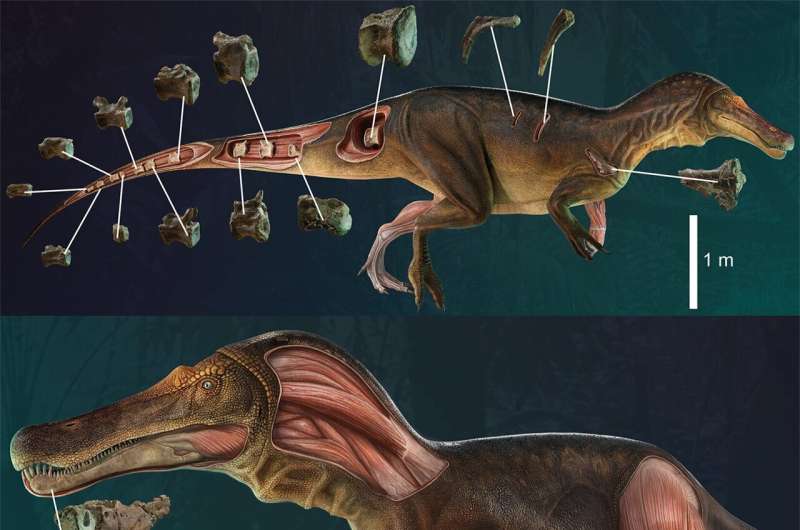February 21, 2022 report
New species of spinosaurid dinosaur discovered in Portugal

A pair of researchers affiliated with both the NOVA School of Science and Technology and Museu da Lourinhã, has found evidence that suggests a group of fossils found 23 years ago in Portugal are the remains of a new species of Spinosaurus—the type of dinosaur featured prominently in the movie Jurassic Park III. They have named it Iberospinus natarioi. In their paper posted on the open-access site PLOS ONE, Octa´vio Mateus and Darı´o Estraviz-Lo´pez, describe the fossils they studied and explain why they believe they belonged to a separate species of Spinosaurus.
Spinosaurids are believed to be one of the largest living carnivores to have ever walked the earth. They were long with large back legs and small front legs, as well as long tails and large heads that somewhat resembled those of a crocodile. They lived during the Mesozoic in Africa and parts of Britain and Europe, most notably on the Iberian Peninsula. Prior research has suggested that they likely lived most of their lives in the water but were quite capable of chasing down prey on land as well. Estimates of their characteristics are generalized as only a small number of fossils that have been found.
In this new effort, Mateus and Estraviz-Lo´pez suspected that the fossil remains discovered in 1999 close to Cabo Espichel, Portugal had been mistakenly identified. For many years, it was believed that the remains were from a single Spinosaurus known as Baryonyx walkeri—so they were given the label ML1190. The fossils included dorsal vertebra, rib fragments, a pubis shaft, dentary fragments, a partial right scapula, a phalanx bone, a public peduncle, and dorsal neural arches.
In taking a closer look at the fossils, the research pair found that they came from a creature that was likely 9 meters long and lived approximately 125 million years ago. In studying where the nerves would have been in the creature's mandible and a tip on the dentary that was straight instead of curved as it was with other Spinosaurids, the researchers found evidence of a unique species. They also found it had a unique bony ridge on its pubis and lacked the type of muscle projections seen with Baryonyx. They gave it the name Iberospinus natarioi, after the Iberian Peninsula, and Carlos Natário, the amateur archeologist who found the fossils.
More information: Octávio Mateus et al, A new theropod dinosaur from the early cretaceous (Barremian) of Cabo Espichel, Portugal: Implications for spinosaurid evolution, PLOS ONE (2022). DOI: 10.1371/journal.pone.0262614
Journal information: PLoS ONE
© 2022 Science X Network





















